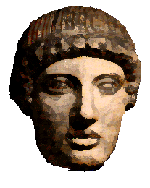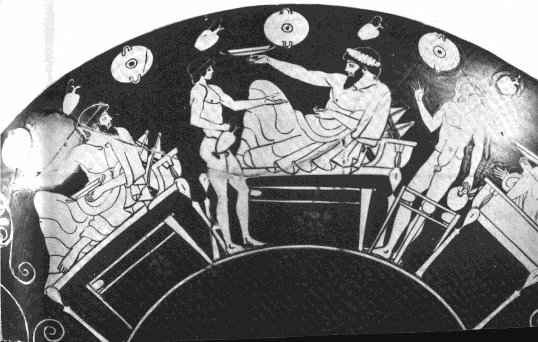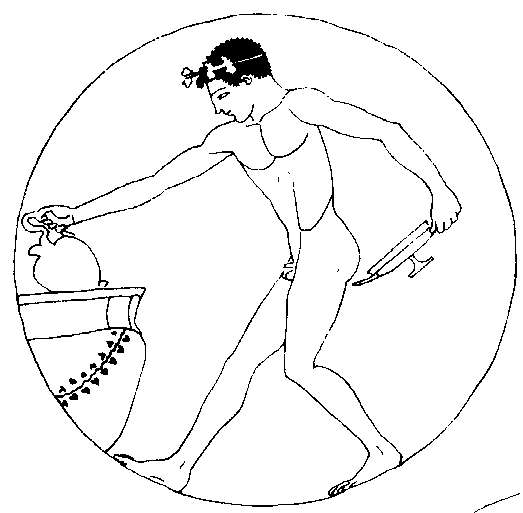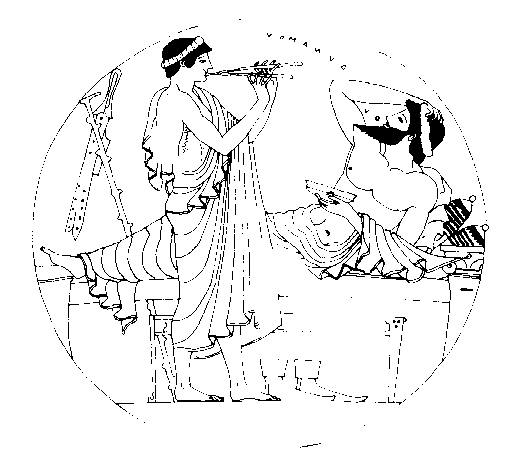Symposium
The drinking party
Men behaving badly
The Equipment and Preparations
Every Athenian house (oikos) had a special room used only for parties. It had built-in platforms around the walls for the couches (Greek men preferred their entertainment in a prone position) - 9 was a common number - and was often the only room with a stone floor. This sloped to the centre to make cleaning it out simpler. The Greek name - andron - means "mens' room" - it was the place where the master of the house (kyrios) entertained his (male) friends. Entertainment for men, then as now, meant food, drink, games, music and - above all - sex.
But there was a formality about an Athenian party which is missing from modern equivalents. The host was responsible for deciding how drunk his guests would get, and how slowly. Intoxication of some kind was unavoidable - no one left a symposium entirely sober. The "rule" for hosts is amusingly explained by the god of wine himself, in a fragment from a play by Euboulos:
"For sensible men I prepare only three kraters: one for health (which they drink first), the second for love and pleasure, and the third for sleep. After the third one is drained, wise men go home. The fourth krater is not mine any more - it belongs to bad behaviour; the fifth is for shouting; the sixth is for rudeness and insults; the seventh is for fights; the eighth is for breaking the furniture; the ninth is for depression; the tenth is for madness and unconsciousness."
So the equipment needed is as follows:
- Couches, tables and footstools for each guest.
- The wine - in two-handled jars known as amphora or pelike
- Water to mix with the wine - in a three-handled hydria
- A large mixing-bowl or crater (Greek krater) - there were various types, such as column crater, calyx crater, volute crater and bell crater. A smaller mixing vase was a stamnos, which would be used for more intimate ocasions.
- A cooler (optional)- the Athenians liked their wine chilled, and a vase called a psykter was used to stand inside the crater.
- Jugs (oinochoe) for pouring the wine/water mixture into cups - or a ladle could be used.
- Drinking vessels of various kinds: the kylix or cup (very shallow, for playing kottabos - see below), the kantharos (two large handles imitating a metal cup), the skyphos (huge - for the professional drinker)
The events of the symposium
The party would start at dusk - although preparations (choosing the wine, hiring the entertainers etc would have been in progress since much earlier). It began with food - the Athenians did not drink with the meal. Each guest would be given a garland to wear on his head. Then the tables would be cleared and the drinking would begin: with the drinking came the entertainment, which could be home-grown or imported. The simplest would be where the guests bring their own instruments and play and sing - and of course kottabos. Kottabos was a game where players flicked the residue at the bottom of their cup (hence the shallow cups!) either at each other - trying to catch it in their own cup, or at a target: trying to knock
something over, or sink a floating object. Professional entertainment was provided by "flute-girls" (or boys) - who were expected to have earthier accomplishments in addition to their musical skill.
Such hetairas would also join in with the kottabos games and other ribaldry. Many vases show uninhibited communal sex as the climax to the evening. Painters show the loss of control by depicting the partygoers as satyrs - men with gross features and horses' tails. Literally party animals!
The Vases
Rich Athenians probably used silver cups and kraters - pottery was cheap, and owes its apparent importance to its indestructability, and to the fact that Athenian pottery was immensely popular with the Etruscans - who lived in central Italy at the time (and gave their name to Tuscany). The Etruscans, unlike the Greeks and Romans, had a very elaborate burial ritual, where the dead were placed in underground rooms, furnished as they would have been in life. The enterprising Athenians sold them pottery for their posthumous symposia (the Etrucans, though, used to party with their wives - an incomprehensible perversion to an Athenian). And so most of the pottery which survives was recovered - much by criminal activity - from these underground tombs in Italy, which can be detected by electronic echo-sounders and robbed with the greatest of ease. Controversy still surrounds the "million dollar vase" (Euphronios' Sleep and Death removing the body of Sarpedon), bought by the New York Metropolitan Museum in the 70s for $1,000,000.
Only a small minority of vases are signed by the potter or painter, but this did not deter the English scholar Beazley from "identifying" literally hundreds of painters from a study of the painters' "handwriting" (idiosyncratic quirks of style such as are used by graphologists to identify actual writing).






